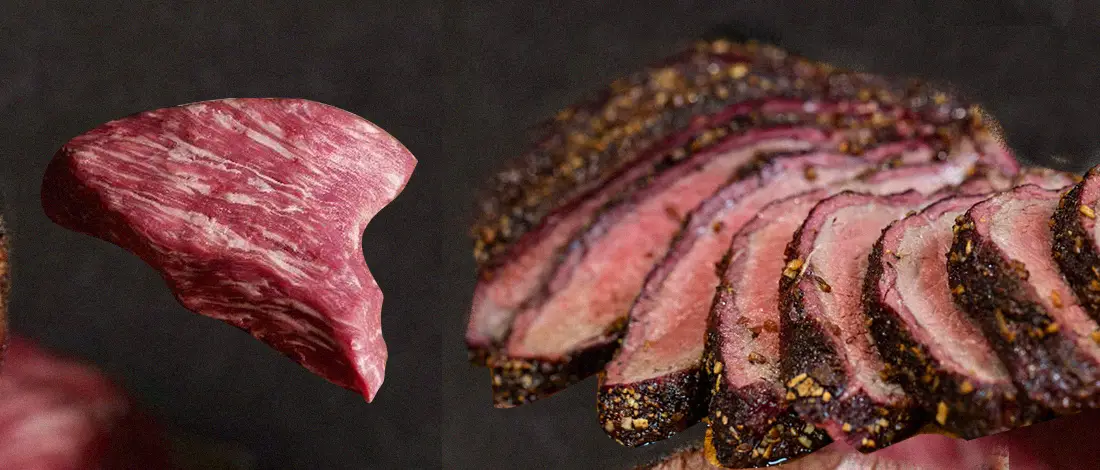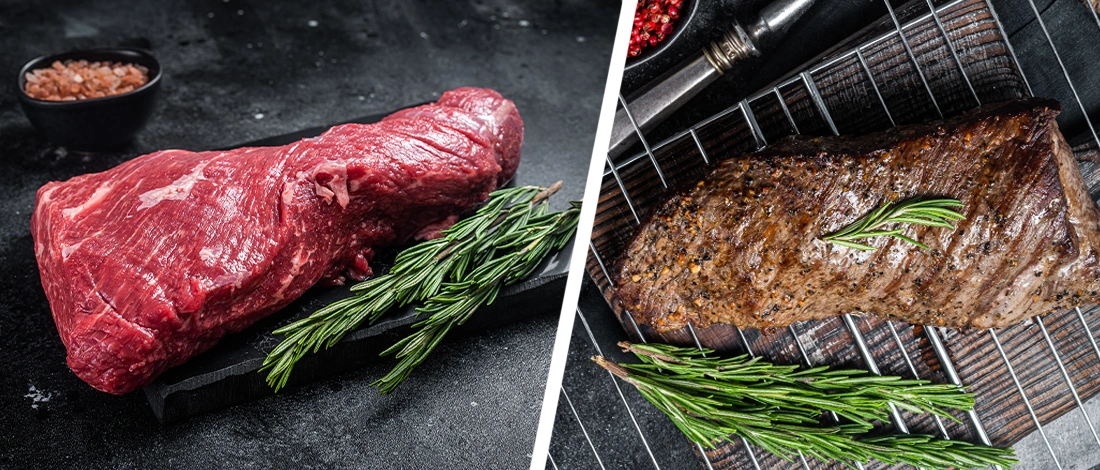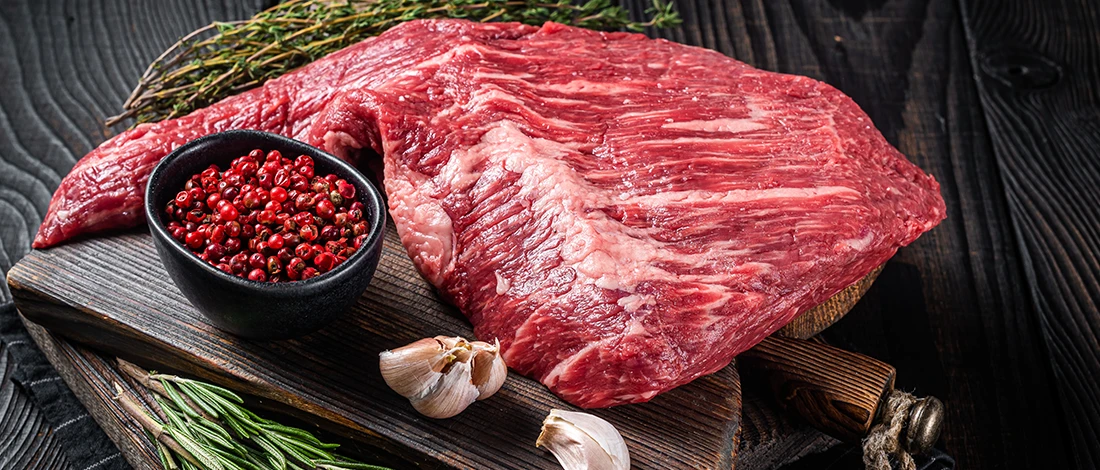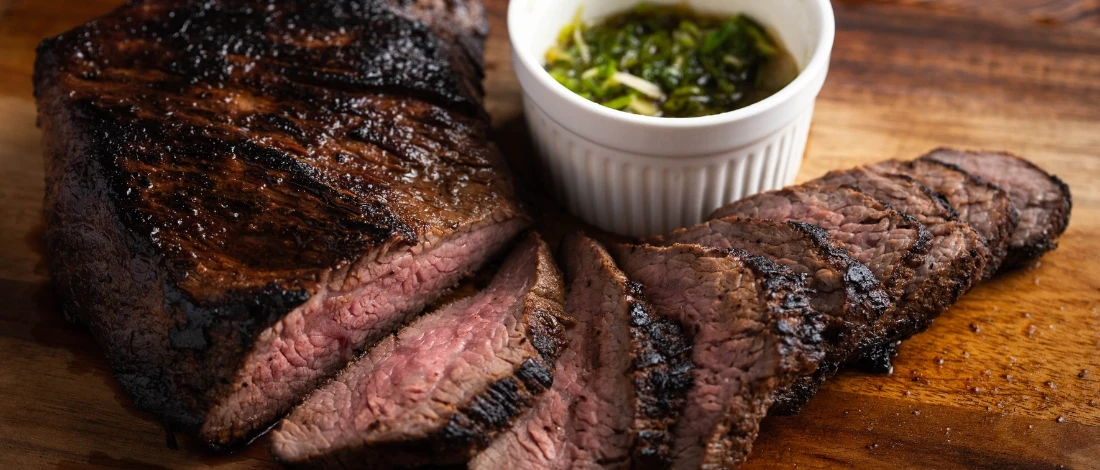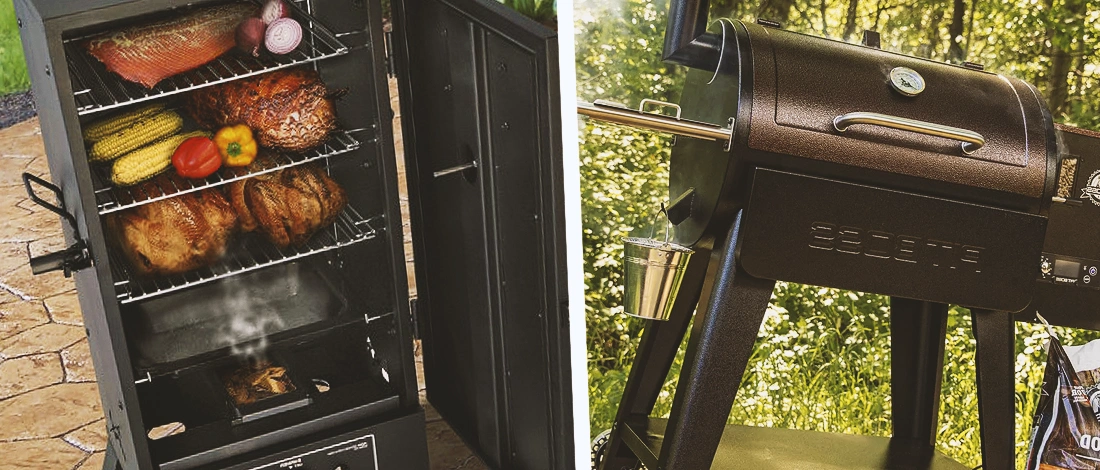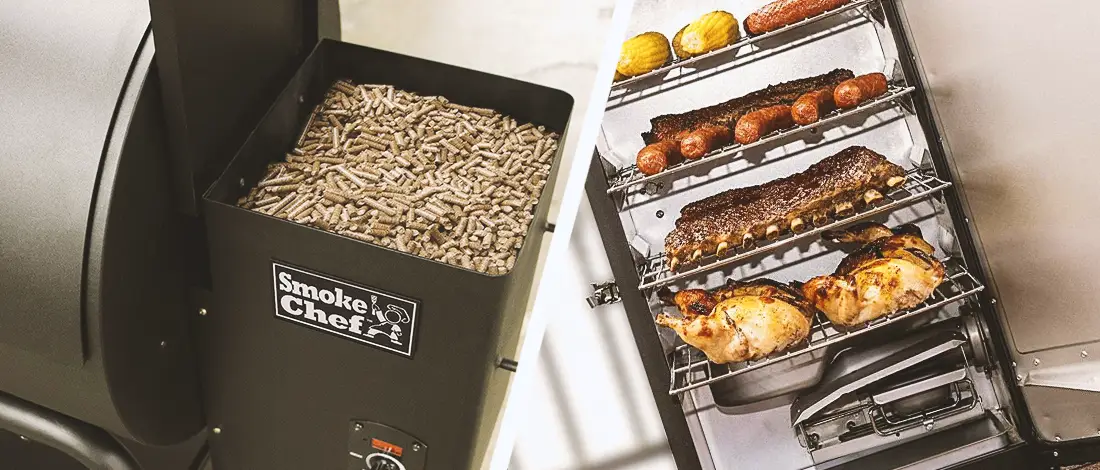Tri-tip and brisket are among the most popular beef cuts. They both have a delicious taste, which is why they are my favorite meats to smoke.
At Carnivore Style, we’re passionate about helping you enjoy these cuts with the best cooking methods and quality meat.
If you’re on the lookout for affordable, delicious brisket and tri-tip cuts, check out our round-up of the best meat delivery services.
I’ve been trying out different cooking methods for tri-tip and brisket for years. Smoking, grilling, oven, slow cooker, you name it, I’ve tried it. Today, I’ll talk about the biggest differences between these two beef cuts so you can decide the best option for you.
Quick Summary
- Tri-tip comes from the sirloin butt, while the brisket comes from the cow’s chest region.
- There are several important differences between tri-tip and brisket, such as the size, cost, flavor, and prep.
- Both tri-tip and brisket can be smoked. The entire tri-tip is smoked in about an hour, while brisket needs at least 12 hours to finish smoking.
Key Differences Between Tri-Tip and Brisket
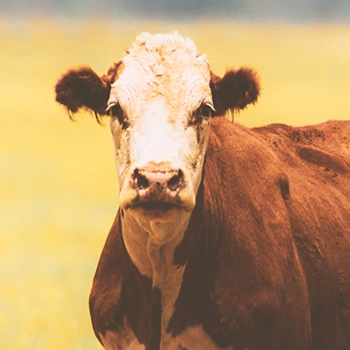
The main difference between tri-tip and brisket is which part of the cow they come from. These two kinds of meat are cut from different portions of the cow.
The brisket comes from the cow’s forequarter (the chest region), while the tri-tip comes from the bottom sirloin.
Brisket is significantly more affordable per pound compared to bottom sirloin grilled tri-tip. However, it is usually sold in smaller portions, so the price difference isn’t that noticeable. Another difference is their size.
Brisket is a large cut of meat and can typically weigh from 8 to 20 lbs. That is because brisket has a lot of intramuscular fat marbling, and it’s made up of two muscles separated by a layer of fat called the point and the flat. On the other hand, the tri-tip is lean and weighs between 4 to 6 lbs.
Finally, these two cuts of meat are prepped differently. You need about 12 or more hours to smoke brisket because the fat cap has to be rendered into collagen.
However, you need about one hour to smoke tri-tip cuts and then sear them over high heat for 30 to 60 seconds.
Also Read: Flank Steak vs Brisket
Comparing Their Features Head to Head

Here are all the biggest features of tri-tip and brisket:
1. Size
I mentioned that brisket and tri-tip differ in size. The latter weighs 3 to 4 pounds on average, and the butcher usually makes smaller portions because of the cut’s location and nature.
One tri-tip can feed a family of 4 people, but if you’ll be serving more people, it’s a good idea to buy more than one. Tri-tips aren’t usually ordered at restaurants because it’s too large for one person.
“A tri-tip weighs roughly two pounds, which makes it more than a single person feed, but the perfect cut for sharing. The tri-tip has a good amount of marbling throughout but is actually quite lean and devoid of any fat caps, so it can be tough if not cooked properly.”
- Jess Pryles, Australian Chef
The brisket can weigh up to 20 pounds. The average size is around 12 pounds. This is a much bigger cut of meat because it contains muscles that the cow needs to stay upright. Beef brisket is a great choice if you’re entertaining large groups of people. Otherwise, you’ll have plenty of leftovers.
Also, you don’t have to buy a full brisket. Because of its size, brisket is often sold divided into two pieces, but it’s still pretty large. You can find a 5 to 6-pound brisket flat or a 3 to 4 pounds brisket point.
Both parts of brisket serve different purposes:
- Point cut — Has more intense flavors and a lot of fat going through the meat. It’s a triangular-shaped cut and is good for shredding.
- Flat cut — Has less fat than the point cut and a fatty layer at the bottom. It’s easy to slice evenly and is usually found in rectangular or square shapes.
2. Cost

If you’re on a budget, the brisket is the winner. It costs less than a tri-tip.
However, an important consideration is that a tri-tip cut is smaller than a brisket cut, so you’ll end up paying more for a brisket than for one tri-tip.
Also, the cost will go up depending on how many people you plan to feed. Brisket pays off because you’ll have plenty of leftovers that you can use to make sandwiches or other recipes.
One con of brisket is that it has a lot of fat, leaving you with less usable meat. You’ll discard about 25% of the brisket weight before you start smoking the brisket. For example, if you’ve bought a 12-pound brisket, you’ll be left with only 9 pounds. Still, buying a brisket pays off for many cooks because you can feed a lot of people.
Tri-tip is expensive because this is a meaty, lean cut. It has much less fat compared to the brisket, and it’s healthy.
This is also why it costs about twice as much as brisket per pound. However, because it weighs around 4 pounds per unit, it’s cheaper than buying a 12-pound brisket.
To sum up, while there are differences in cost, once you factor in how much meat you get, they end up costing about the same.
When you cook a whole brisket, you lose between 25% to 50% of its weight, and if you cook three tri-tips, you’ll end up with the same amount of meat as a whole brisket for a similar price.
Pro tip: The price of the brisket also depends on which part of the brisket you get. A flat cut is more expensive than a point cut.
3. Flavor
There are differences between tri-tip and brisket flavors. Smoked tri-tip has the robust, beefy, buttery flavor you usually have on a lean steak because of its fat content.
You'll love tri-tip if you like ribeye, sirloin, and other lean steaks.
The packer brisket flavor profile is more complex. It also has a strong beef flavor with bark and smoke rings because of the long smoking process.
Properly smoked brisket looks as if it's been burnt to a cinder, but you'll see a crispy bark on the inside when you cut it. This gives brisket more flavor.
Smoked brisket tastes similar to chuck roast, as both of these are tough, fatty muscles.
4. Cooking Speed
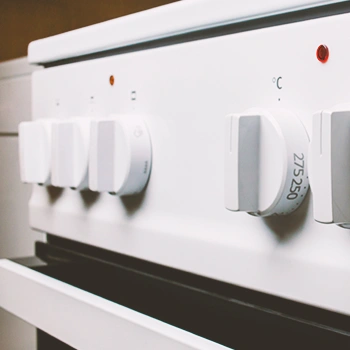
Tri-tip roast is also called Santa Maria steak. This steak is usually grilled with simple seasoning over an oak fire on a raised cooking rack.
You’ll know the whole tri-tip is cooked when it reaches the internal temperature of 145 degrees [1]. This usually takes about 45 minutes to an hour.
Then you should place the whole tri-tip on charcoal for a couple of seconds to get an outside sear.
It takes much longer to cook brisket because this is a combination of two incredibly tough muscles with a lot of inner connective tissues that need to break down, so the meat becomes tender.
The average brisket cooking time is from 6 to 14 hours. Brisket is better slow-cooked than tri-tip. You’ll know the brisket is done when it reaches an internal temperature of 195 degrees [2].
5. Preparation
Here are the tri-tip and brisket preparation instructions.
Lean meat cuts need a shorter cooking time than the fattier ones. This means the entire tri-tip doesn’t need to be smoked for half a day. Instead, you can prepare it like you would a steak. Smoke it for an hour and then sear on each side.
To prepare tri-tip steak for smoking, you should slice off the untrimmed tri-tip fat cap. Many bought tri-tip steaks come with the fat cap already sliced off, so all you need to do is season as desired.
You can use household spices such as salt, pepper, oregano, and garlic for the rub. You can also marinate the tri-tip overnight in olive oil.
Brisket requires more prep before starting the cooking process. It should be smoked for at least 90 minutes per pound at a low internal temperature.
If you have a frozen brisket, make sure it’s completely defrosted before cutting the fat cap. This can take up to a few days if you have a very large cut, so you should place the brisket in the fridge 72 hours before smoking it.
Once the brisket is defrosted, it’s trimming time. Make sure to leave some fat from the fat cap on it to add flavor and make the brisket juicy and tender, but remove the fat on the underside of the brisket. It’s usually a quarter of an inch thick, which is too much fat.
Pro tip: My strong suggestion is to go slowly when trimming the brisket. It’s better to go back and trim more than to trim too much. You’ll know you’re done trimming when there aren’t any rough fat areas.
“A whole packer brisket has a point that lays on top and the flat. There are two sorts of muscles, and the grains run in different directions. When trimming, open it up fat side, so you don’t run the meat and keep all the juice contained in the bag.”
- Not Another Cooking Show, YouTube Channel
When you’re done trimming, season the brisket with a rub you prefer. I like to use brown sugar because it glazes the outer edges of the meat. Let the rub sit for an hour or two so it’s absorbed into the meat.
You can also marinade brisket. Seal the cut into a container with the marinade and place it in the fridge for one day. Marinading is great for getting a tender end product.
How to Cook Tri-Tip?

Once you’re done prepping the tri-tip, it’s cooking time. My favorite tri-tip cooking method is smoking. Here’s a step-by-step guide on smoking tri-tip:
- Let it sit at room temperature while your smoker reaches 250 degrees.
- Smoke the tri-tip for an hour or until it reaches 135 degrees internal temperature.
- Sear the meat on both sides for 30 seconds per side.
- Let the tri-tip rest for about 20 minutes so the juices redistribute evenly. You can wrap it in aluminum foil, so there’s less leakage.
- Slice the meat across the grain and serve
There are also other tri-tip cooking styles. You can sear the meat for a few minutes, roast it until it’s done, or spit-roast it on a rotisserie.
Read More: The Best Meat for Rotisserie
How to Cook Brisket?

Once you’ve prepped the brisket and let the rub set, it’s time to smoke. Here’s my step-by-step smoking brisket guide:
- Set the smoker to 225 degrees.
- Place the brisket on the smoker with the cat up.
- Smoke the brisket for an hour and a half per pound. Once the brisket reaches 150 degrees, the internal temperature will stay the same for several hours. This is called the stall, and it’s normal. All you have to do is wait.
- When the brisket reaches 195 degrees, take it out of the smoker. Wrap it in aluminum foil and let the meat rest for an hour so the juices can settle and the fat gelatinize.
- Take the brisket out of the foil and cut against the grain.
This is the most popular brisket cooking style, but you can also do it in the oven, on a stovetop, slow cooker, or smoke on a grill.
Related Articles:
At Carnivore Style, we want to help you choose and cook the best cuts for your carnivore lifestyle. Check out our other guides and recipes to master your favorite meats.
References:
- https://www.kingsford.com/recipes/series/perfect-beef/how-to-grill-tri-tip/
- https://www.charbroil.com/how-tos/smoked-brisket-temperature-guide


